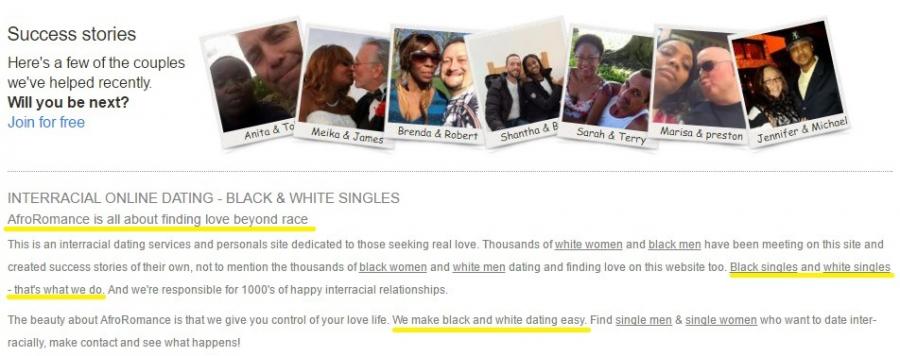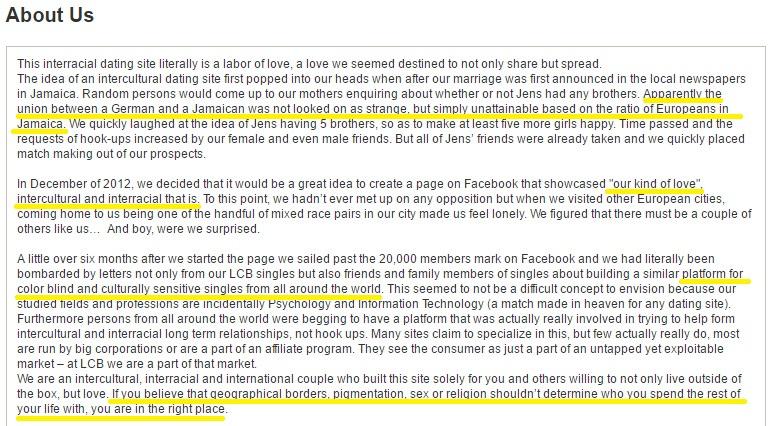
Racism and online interracial dating communities in the 21st century
How online interracial dating communities function
The emergence of the internet has provided us with all kinds of dating communities on websites and social media. This paper discusses how online interracial dating communities function in the 21st century.
Interracial dating communities
About 75 year ago, my then approximately 8-year old grandfather slammed the door shut when he saw a black man in front of him, who was trying to sell nuts to people in the neighbourhood. He told me he had never seen a person with a different skin colour than white in his life, which scared him and made him run away from the man. During this time, he could have never imagined that only two generations later, one of his closest family members would get into a relationship with someone with another skin colour: interracial relationships were not usual then, definitely not in the village where he lived. When my 86-year old grandmother heard I had a black American-Kenyan boyfriend, her first reaction was: ‘’A black person does not belong in our family’’.
In the 21st century, a lot has changed in attitudes towards people from different races: no child would run away from seeing a black man on the street and comments like my grandmother’s have become at least remarkable. However, this does not mean that racism has disappeared: the discourse of my grandmother and grandfather is still with us today. The development of digital technologies has provided new knowledge on all kinds of romantic relationships. The existence of the internet gives us access to various attitudes towards other races, cultures and ‘mixed’ couples. Through ethnographic research, this paper provides a description of how online interracial dating communities function in the 21st century. Because of my own situation, this paper will especially focus on black-white dating and relationships.
This paper takes digital ethnography as an approach as it ''can make substantial contribution of the study of present-day digital communication environments and our digital culture(s)’’ (Varis, 2015, p. 1). When examining others and partly myself, it has to be noted that ethnography is ‘’always a work of interpretation of complex social phenomena’’ (Hymes, as cited in Maly, 2016, p. 5). I should also mention that it is not my belief that races are ‘out there’, but are rather socially constructed. In my eyes, there is only one race: the human race. In that sense, race is always a construct. Therefore, I would much rather use the word 'intercolour' than 'interracial'. Still, I use the terms ‘interracial’ and ‘race’ in this paper as this is how it is mostly referred to in society and within other research.
Norms in Online Media
In order to understand how online interracial dating communities function, it is important to know in which online environment these communities function. Google Image provides us with interesting ideas about what is perceived as a ‘normal’ couple, and whether interracial couples are part of this ‘normality’.
It should be noted that - before displaying the findings of the Google search study - the results I get in Google search are the effect of my own algorithmic bubble: Google is not creating one reality, but creates algorithmic bubbles, which ''shape, or reinforce, our world view based on what we want to see or what is relevant to us instead of what we would rather not see but may need to see'' (Hossain, 2016). These bubbles are based on online behaviour, location, language, etc.: if someone would search for 'normal relationship' and 'normal couple' in - for example - Arabic in Libya, that person would get different results than I get, as I search these terms in English from a place in Europe.
However, it is still useful to look at the findings of this Google search. Elad Segev (2010, p. 170) found by examining the biases of online news through Google News that ‘’the USA and other English-speaking countries dominate content, and consequently empower their global vision and priorities’’ and by ‘’looking at global mass media channels...it is the popularity and dominance of the US actors...and English content that often reflect US and Western views’’. Besides, most online content is generated in English: Tagg (2015, p. 51) stated that ''while English users make up nearly 27 per cent of internet users, the percentage of web content in English is much higher (57 percent)'' and ''English will remain a dominant prescence online for some time''. This means that this study will provide us with a view of the dominant ideas in the online world with regards to romantic relationships.
In my Google search, I have chosen to search the terms ‘normal couple’, ‘couple’, ‘black couple’, and ‘white couple’ in Google Images. The results are listed below. By searching:
- ‘Normal couple’, only white couples show up.
- ‘Couple’, only white couples show up again.
- ‘Black couple’, only black couples are presented.
- ‘White couple’, mainly interracial couples are shown.
Google suggests that ‘normal couples’ and ‘white couples’ are the same kind of couples, as both of these searches only result in images of white couples. This implies that white couples are perceived as the ‘norm’. Therefore, it is necessary to add ‘black’ to ‘couple’ in order to get pictures of black couples, while adding ‘white’ to ‘couple’ seems to be completely unnecessary and even inefficient, as only interracial couples show up. In order to find pictures of white couples, it is more efficient to just type in ‘couple’, as, according to Google search, couples are white, ‘normally’.
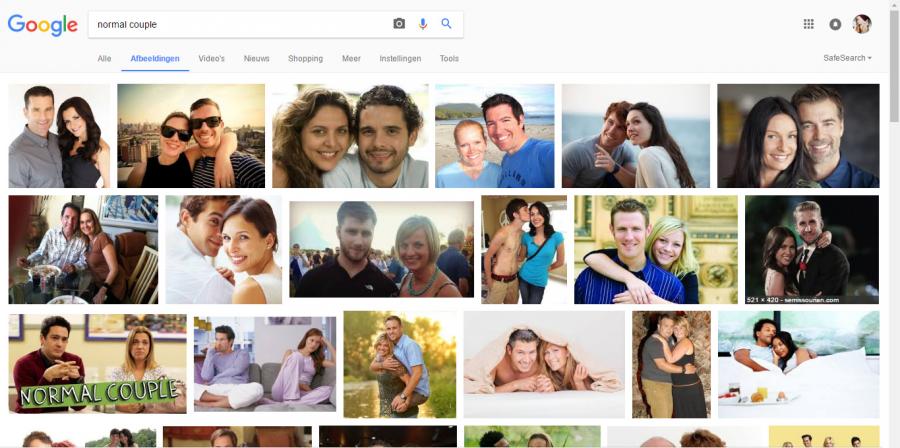
Google Image search: 'normal couple'
Small probes such as this one, suggest the online dominance of Western norms and white people. This means that these Western views on relationships are most easily captured online and are the first ones people find when searching information about this topic. The nuance needs to be added, however, that I have searched for these terms in English, from a place in the West.
Online Interracial Dating Communities
In the 21st century, the term ‘multiculturalism’ is not enough to describe the diversity among people in society. Due to new migration patterns after the fall of the Berlin Wall in 1989, the term ‘superdiversity’ has been introduced by Vertovec, adding ‘super-’ to ‘diversity’ in order to describe an evolution towards a ''complexity surpassing anything…previously experienced’’ (as cited in Maly, 2016, p. 2).
Superdiversity can be linked to the changes in communication technologies: new media not only function as infrastructures of transnational people, such as migrants, but they also create cultural niches within which translocal micro-populations arise (Maly & Varis, 2015). This means everyone can live a superdiverse life, which can be achieved by participating in online communities for instance. Dating sites and applications, on which someone can find a partner based on their interests and preferences, have become very popular in the 21st century. The emergence of dating sites meant the development of niche online dating communities in which the participants focus on specific traits. Interracial dating communities are such niche communities, as the individuals who are part of them are (only) interested in dating a man or woman from another race. Nowadays, there are plenty of these dating sites available.
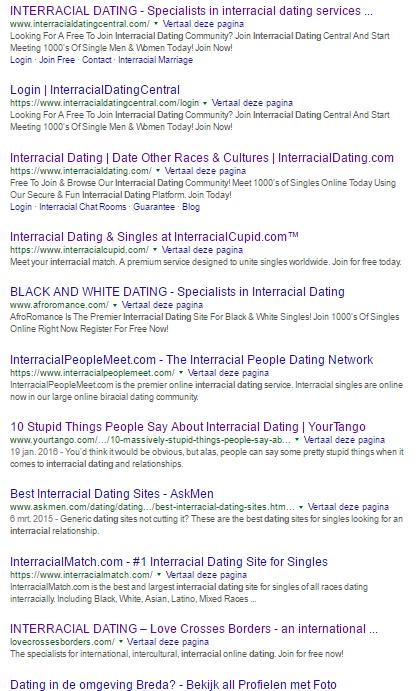
Google Search: 'interracial dating'
The next section will provide a description of three interracial dating sites: www.afroromance.com, www.interracialmatch.com and www.lovecrossesborders.com. The first one mentioned will be discussed elaborately in order to provide us with an idea of how members of such interracial dating communities function.
The goal of the interracial dating website www.afroromance.com is ‘’finding love beyond race’’. Though, at the same time, the site seems to allow dating between a white person and a black person only: ‘’Black singles and white singles – that’s what we do’’. This shows that the website does not really look beyond races, but rather emphasizes them. Furthermore, an important function of the website is that it makes ‘’black and white dating easy’’, which implies that this ‘kind of dating’ is more difficult in the offline world.
The website suggests that it only allows black and white dating and excludes other races, such as Asians. However, this is not the case, as they also allow other races besides black and white to use the website. This is not obvious from looking at the home page, which means it could accidentially exclude other races from signing up.
When signing up for the website, you have to provide your 'ethnicity' and the 'ethnicities' you are interested in. You can also show others you are interested in any 'ethnicity', though most people who use the website specify their preferences in the option 'Looking for a:'.
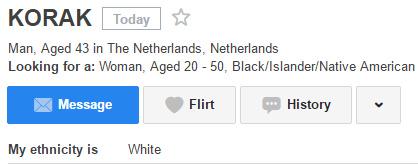
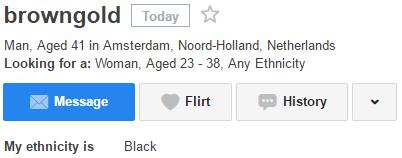
Some people even explicitly express their own 'ethnicity' and their preference for a certain 'ethnicity'.
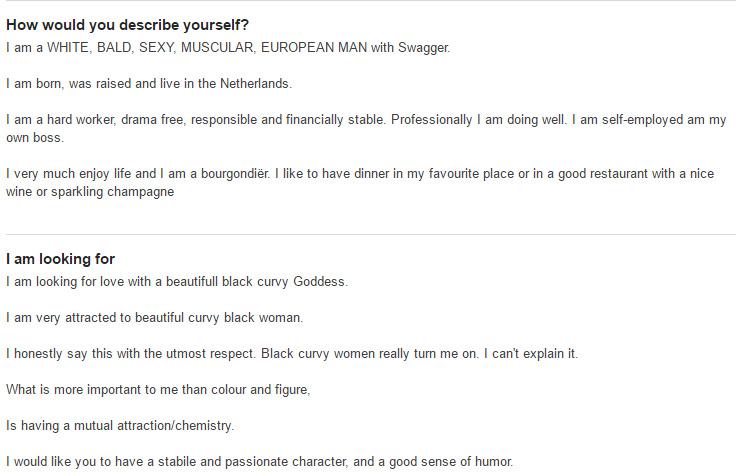

'Ethnicity' has been used incorrectly by this dating website, as it presents white / European descent, black / African descent, Native American, Asian, and Islander as ethnicities. The term ’ethnicity’, however, refers to cultural factors, such as nationality, language, regional culture, and religion. It is also about tradition, learned behaviour and customs. This means that the website implies, for example, that all black people have the same ethnicity, which is not the case: a black Kenyan does not have the same ethnicity as a black American, for instance. When talking about race, however, one is referring to someone's physical characteristics, such as skin, hair, or eye colour. Even though a black Kenyan man and a black American man are both black, and share the same race, this does not mean they have the same ethnicity. The website seems to mix up race (or rather, physical features) and ethnicity, which could mean they put people - probably unconsciously - into certain cultures, or boxes broadly speaking, based on their appearances. This makes the website an example of how categorial terms such as 'ethnicity' are streched and how users, apparently, do not object to such stretching.

It is also possible to do 'quick searches' on the website, which provides members to quickly find the race (or 'ethnicity', according to the website) of their interest. The interest of the people signing up on the dating site lies especially with the other's race. Again, this shows they do not actually go beyond races, but rather emphasize them.
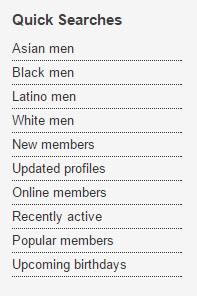
Not all interracial dating websites suggest that they focus on black and white dating alone. www.interracialmatch.com, for instance, focusses on dating between all 'races'. Their goal is to ‘’bring like-minded singles together under one ‘roof’ and help them go about with their interracial dating and even cement interracial relationships’’. Moreover, this website argues that it is more difficult to establish interracial relationships in the real world ‘’due to time and work constraints’’.
What’s more is that this site functions through the concept of ‘authenticity’: ‘’This truly makes us stand out from the entire cluster of other dating sites on the internet, because unlike them, our members start out having something in common: a love for singles from other races and ethnicities’’. They argue they 'stand out' from other dating sites, because of the members' love for people with a different ethnical or racial background. Besides, by saying ‘’a love for singles from other races and ethnicities’’, this site emphasizes racial differences as well, instead of really going beyond them.
The dating site www.lovecrossesborders.com also argues that interracial and intercultural dating is more difficult in the offline world, as there seems to be a lack of racial and cultural diversity, in this case in Jamaica. The site presents itself as a ‘’platform for color blind and culturally sensitive singles from all over the world’’, who ‘’believe that geographical borders, pigmentation, sex or religion shouldn’t determine who you spend the rest of your life with’’. So, the website tries to ‘normalize’ ‘mixed’ relationships.
This website presents intercultural and interracial dating as something ‘authentic’ by showcasting ‘’‘’our kind of love’’, intercultural and interracial that is’’. ‘Our kind of love’ implies that the website deals with something authentic: they suggest it is a different ‘kind of love’, namely an intercultural and interracial one. This suggests that they are, in fact, not ‘colour blind’, but see interracial dating as something ‘abnormal’ or ‘different’, though they give meaning to this ‘abnormality’ in a positive sense of uniqueness or authenticity. While all dating sites imply that their primary objective is to find you true love, they compete with all other dating sites out there and are driven by consumerism, arguing they are ‘unique’ in the online dating business and you should choose to sign up for their site instead of others’.
Online media, such as Facebook, are involved in creating online interracial dating communities as well.
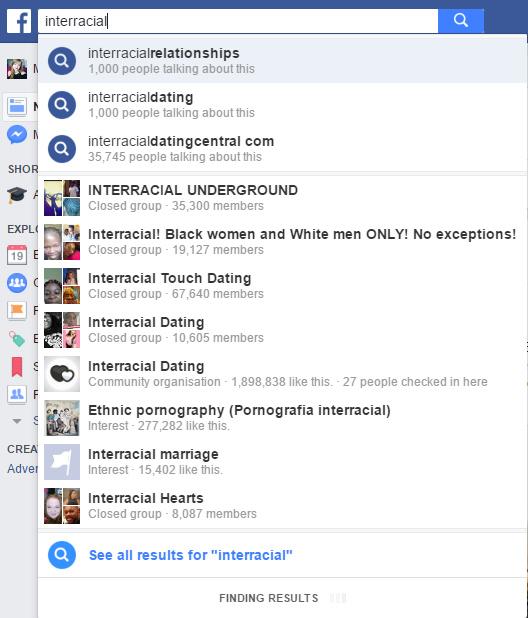
Interracial dating communities on Facebook
Becker (1963, p. 1) argues that ‘’all social groups make rules and attempt, at some times and under some circumstances, to enforce them. Social rules define situations and the kinds of behavior appropriate to them’’. ‘Outsiders’, then, are ‘’people who are judged by others to be deviant and thus to stand outside the circle of ‘’normal’’ members of the group’’ (Becker, 1963, p. 3). As we have seen in the previous section, interracial couples seem to stand outside the circle of ‘normal’ relationships. Still, we can apply Becker’s knowledge on ‘deviant’ online communities as well, as these communities also make rules and decide what is ‘normal’ in their own group, which excludes other people, or, how Becker would put it, creates ‘outsiders’.
Looking into the Facebook community named ‘INTERRACIAL UNDERGROUND’, thirteen rules are clearly defined in the description. If a member of the group violates one of these rules, he or she will be ‘booted’ (banned). The second popular Facebook group for interracial dating is ‘Interracial! Black women and White men ONLY! No exceptions!’. With around 20,000 members, this group is less popular on social media compared to the previous one, and its name can be seen as a clear indication why. The owners of this Facebook community include – unlike the owners of ‘INTERRACIAL UNDERGROUND’ – only white men and black women, and thus, as the description tells us ‘’are not allowing in this group any Indians, Arabians, Asians, Turkish, black men or white women’’. People who do not fit the categories of either white men or black women and still try to sign up for the community ‘’will be threaded [treated] as an intruder for not respecting the main purpose of this group and shall therefore be banned’’ and thus treated as outsiders. Also noteworthy is the name of this community. By using the word ‘underground’, it suggests that the community exists outside the mainstream society of culture, and could be perceived as a counter-culture with its own rules.
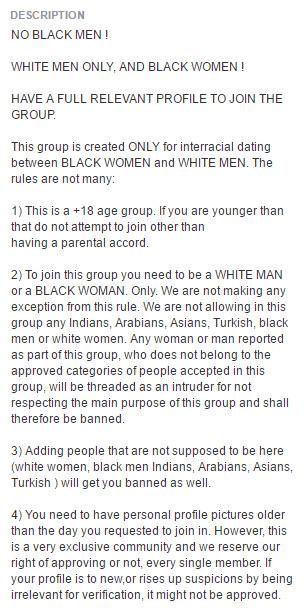
Rules of 'Interracial! Black women and White men ONLY! No exceptions!'
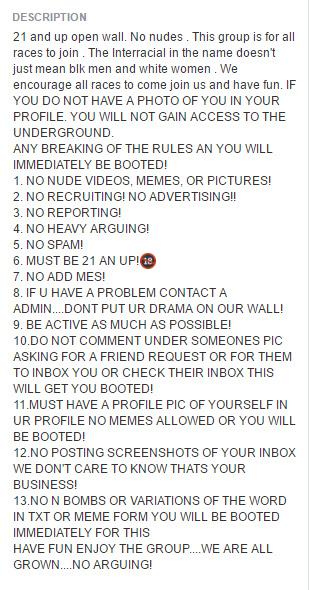
Rules of 'INTERRACIAL UNDERGROUND'
All people engaging in interracial communities seem to have a certain 'love for the other'. 'Otherness' is in fact embodied in stereotypes: ''stereotypical images of the cultural other have become enmeshed with intimate personal desire - which we often regard as deeply individual'' (Piller, 2011, p. 112). If I would have signed up for one of these communities, because I have a desire for the culture and race of 'the other' and would have met my boyfriend there, I would have been disappointed: our culture, way of life, etc. is not that different. In a superdiverse world, it has become very complex to talk about race or ethnicities. We can not determine which culture, country, type of behaviour, etc. someone identifies with by only looking at their appearance. Someone should not be placed into a box based on their appearance. Stereotypes often do not match reality. Futhermore, the love for certain stereotypes is not merely an individual feature. Instead, it is part of a wider, socially shared discourse, which will be discussed elaborately in this paper.
Memes
When looking at memes about romantic relationships, there are way more memes about interracial couples than there are about white couples to be found online. Moreover, most of these memes are about black and white people in a relationship.

Google Image Search: 'meme interracial couple'
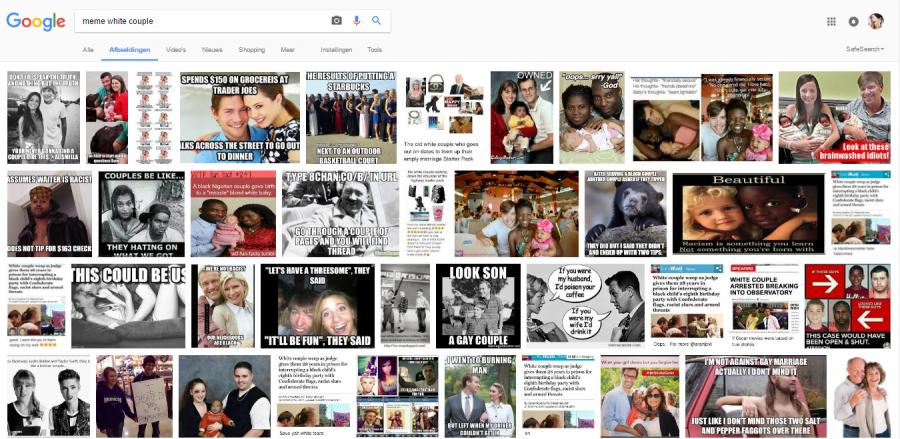
Google Image Search: 'meme white couple'
As argued before, the West and white people are the norm on the internet, which make white couples ‘normal’ couples. It is not unexpected to see that interracial couples are more often made fun of in the form of memes, as ‘’the world of the joke involves the abnormal’’ (Oring, 1992, p. 81). Many jokes regarding interracial couples are negative: some imply parents will not be proud of you if you are in a relationship with someone outside your race and some suggest that race-mixing is something you should not get involved in.
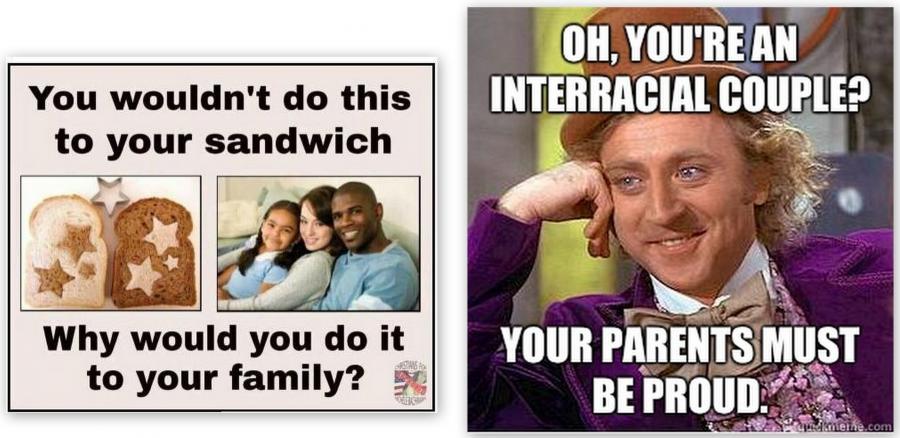
Moreover, many of these negative jokes are based on black stereotypes, such as the idea that black people love chicken and melons, black men leave their partners after they get a child, and some even express the thought that black people are closer to apes than white people.
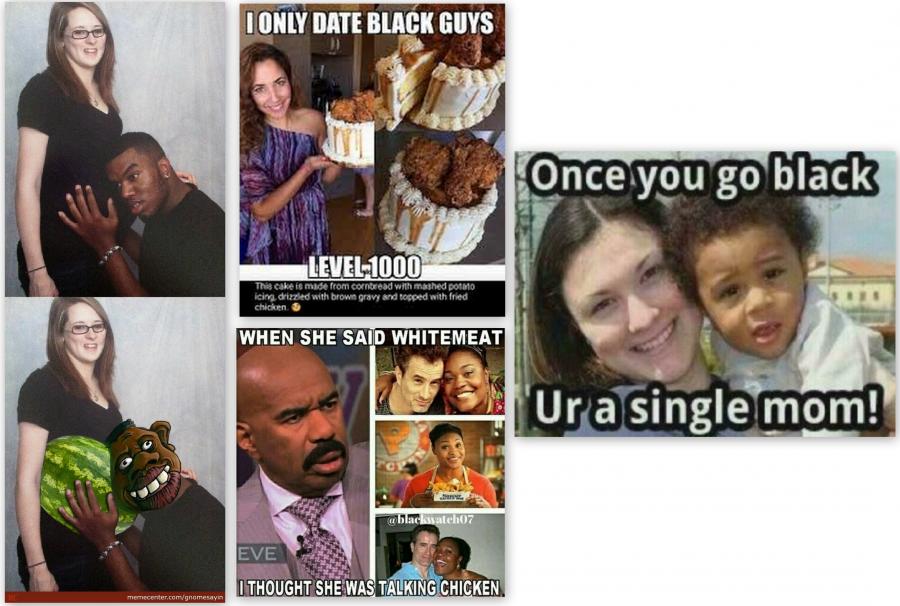
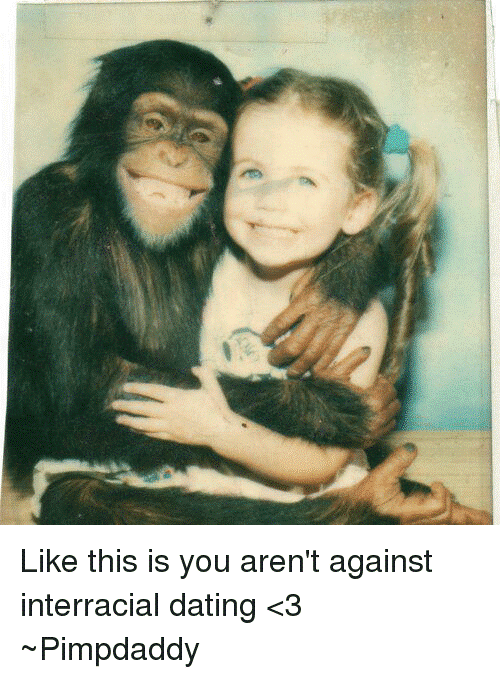
Controversially, memes are also made for expressing support towards interracial relationships in a funny manner.

Part of the controversy over interracial couples is expressed in antagonistic memes. There are different niches among people in society: on the one hand, people give meaning to interracial dating in a negative way and make racist jokes about it, and on the other hand, people give meaning to it in a positive sense and express support towards these couples.
Racist Discourse
One of the key principles of doing digital ethnography is ‘non-digital-centric-ness’, which implies that the digital is de-centred in digital ethnography (Pink et al, 2016, p. 9). Pink et al. (2016, p. 9) state that always putting media at the centre of studying media ‘’would be problematic because it would pay too little attention to the ways in which media are part of wider sets of environments and relations’’. Thus, they argue, ‘’in order to understand how digital media are part of people’s everyday worlds, we also need to understand other aspects of their worlds and lives’’ (Pink et al., 2016, p. 10). This means that explanations for the way online interracial dating communities function are to be found in the offline world.
The ‘abnormality’ around interracial couples, reflected on the internet and on social media, finds its origins in racist thinking, or racist discourse, of European powers – such as Great Britain, France, Portugal, Spain, The Netherlands, and Belgium – which sought worldwide European domination starting in the seventeenth century. Their urge for expansion included creating colonial markets, which boosted Europe’s economic and social development. At the core of this expansion was the Atlantic slave trade – the forced migration of Africans across the Atlantic Ocean for slave labour on plantations and in other industries – and racist discourse:
‘’Racist discourse is a form of discriminatory social practice that manifest itself in text, talk and communication. Together with other (nonverbal) discriminatory practices, racist discourse contributes to the reproduction of racism as a form of ethnic or ‘’racial’’ domination. It does so by typically expressing, confirming or legitmating racist opinions, attitudes and ideologies of the dominant ethnic group’’ (Van Dijk, 2004, p. 351).
For example, the discourse of stereotyping black people as children and animals protected Western powers from charges of exploitation
Hondius (2014) argued that through racist discourse, ‘’the concept of race...has enabled the construction of racial hierarchies that justified racist regimes far beyond European borders’’. For example, the discourse of stereotyping black people as children and animals protected Western powers from charges of exploitation: ‘’caring for the infant, domesticizing or taming the animal, are both positive’’ (Hondius, 2014).
Orientalist discourse has played an important role in stereotyping 'the other' by Western powers as well. Orientalism, a term coined by Edward Said (1978, p. 1), refers to ''a way of coming to terms with the Orient that is based on the Orient's special place in European Western experience''. Furthermore, he describes the Orient as ''not only adjacent to Europe; it is also the place of Europe's richest and oldest colonies, the source of its civilizations and language, its cultural contestant, and one of its deepest and most recurring images of the Other''.
In general terms, orientalism is a racist discourse based upon an ontological and epistemological distinction made between 'the Orient' and 'the Occident'; the basic distinction between East and West. Historically, orientalism refers to a Western style of dominating, restructuring and having authority over the Orient. Said (1978, p. 73) argues ''the Orient for Europe was until the nineteenth century a domain with a continuous history of unchallenged Western dominance''. The Orient is thus a European invention: on the one hand, ''a place of romance, exotic beings, haunting memories and landscapes, remarkable experiences'' (Said, 1978, p. 1), and, on the other hand, ''there is the motif of the Orient as insinuating danger'' (Said, 1978, p. 57). Online interracial dating communities do not present other races as dangerous, but they do exotify 'the other', which shows they do not go beyond racist discourses.
'The other' has been mostly treated as a dangerous individual. In 1664, for instance, Maryland passed the first British colonial law banning marriage between white people and slaves; a law which did not make any distinction between free black people and slaves. In 1691, Virginia was the first American state following the British example in banning interracial marriage, which was followed by many other American states. In 1883, with the Pace v. Alabama, the US Supreme Courts announced that ‘’[I]f any white person and any negro, or the descendant of any negro to the third generation, inclusive, though one ancestor of each generation was a white person, intermarry or live in adultery or fornication with each other, each of them must, on conviction, be imprisoned in the penitentiary or sentenced to hard labor for the county for not less than two nor more than seven years’’ (as cited in Head, 2017).
The end of the colonial empires meant a change in Europe’s attitude towards non-white immigration, which provoked interaction and segregation. After World War II, the presence of black people in Europe created mixed feelings among white citizens: there were both strong feelings of supremacy and racism, as well as an ideal and wish to leave traditional ideas of racial differences behind. These contradictions gradually developed into a ‘’general antiracist norm’’, in which the concept of ‘’‘’human races’’ could by now be considered as a thing of the past, considering the generally accepted insight that human races do not exist’’, but are socially constructed instead (Hondius, 2014). While constructionism is ‘’a belief in absolute agency’’, it is also ‘’a belief in the importance of society in constructing everybody’s personal identity on the other’’ (McKee, 2005, p. 53). The importance of society in constructing someone’s identity is about the impact of external factors that influence who we are. In the post-war context, people generally started believing that race is created by society and does not contain characteristics which belong to an ‘authentic core’ of a certain race.
New attitudes towards race meant overturning the Pace v. Alabama by the US Supreme Court by introducing Loving v. Virginia, which made interracial marriage legal in all the American states. Interracial marriages have increased a lot since then: in 2013, a record-high 12% of newlyweds married someone outside their own race in the US (Wang, 2015). However, white and black people are less likely to marry people of another race: only 7% of white and 19% of black newlyweds in 2013 married someone outside of their race.
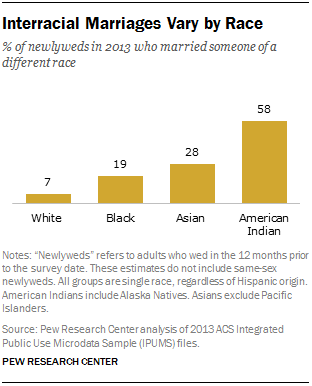
Though the idea of race as something that is socially constructed became more important in scholarly debates, it has not accomplished much according to African-American historian Berlin (1998, p. 1): ‘’Few people believe it; fewer act on it. The new understanding of race has changed behaviour little if at all’’. I do not agree that it has not changed anything at all, based on the new positive attitudes and increase in interracial marriages. However, essentialism, the belief that ''women and men, Black people and white people, straight people and Queer people, each have a particular ‘essential’ culture that belongs to them’’ (McKee, 2005, p. 53), is still alive in today’s society in the form of stereotypes and prejudices. As depicted in the previous section, stereotypes and prejudices are used in judging interracial relationships between a white and black person online, often in the form of memes. The meme which presents a white girl hugging a monkey, shows that ‘bestialization’ – the ‘’inclination of Europeans to regard and to treat Africans and Asians as animals’’ (Hondius, 2014) – is still apparent nowadays.
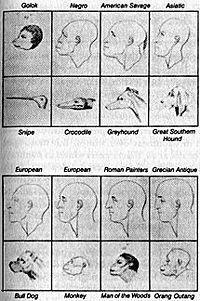
By Charles White (1799), a British fellow of Royal Society and a leader in physics. White wrote that ‘’in whatever respect the African differs from the European, the particularity brings him near to the ape’’ (as cited in Bynum, 2012, p. 272)
Moreover, the stereotype that black people love chicken has its origin in colonialism and its racist discourse, as chickens had been important in diets of slaves in the Southern states (Demby, 2013). The same counts for melons: free black people in the US grew, ate, and sold watermelons, and by doing so, they made the melon a symbol of their freedom. Southern white people, who rejected their freedom, made the fruit a symbol of the black people’s dirtiness, laziness, childishness, and unwanted presence (Black, 2014). These remnants of biological racism are described as ‘embodied racism’ by Weaver (2011, p. 67), which is ‘’racism with an order-building and hierarchical propensity, and an invention of modernity alongside of the development of race itself’’. These memes seem to be innocent, but are in fact embodied in racist ideas developed centuries ago, in order to justify Western dominance, disguised and justified in the thought that ‘it is just a joke’.
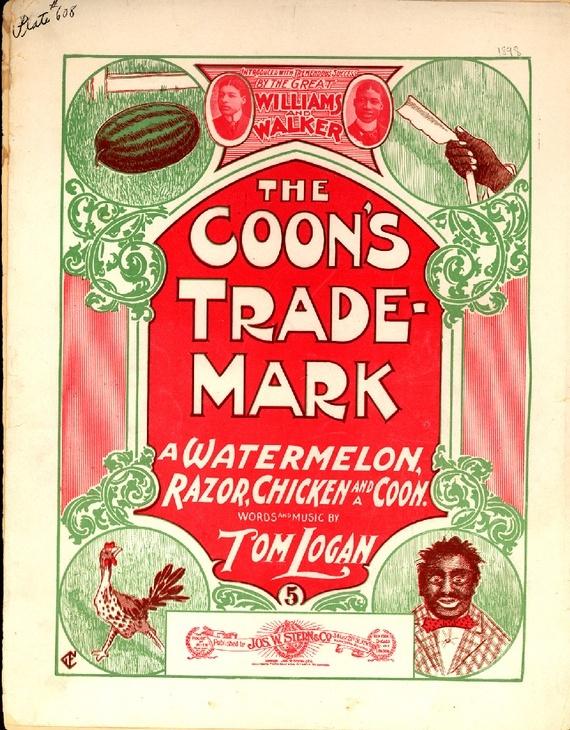
Coon songs’ were tunes that made fun of African-Americans for their laziness and childishness. ‘Coon’ is an insulting term for a black person or refers to a black actor or actress who stereotypically portrays black people
I have experienced these types of ‘jokes’ as well, especially jokes relating to sex: people saying things such as ‘’it must hurt’’. Or people joking that I am getting ‘’the taste for it now’’, as I went from a Moroccan boyfriend to a black boyfriend (the person who said this, said this in a negative way: he meant going from bad to worse). Normally, we do not feel very offended by such comments. However, it does show implicit racism is still with us today, leading to unconcious biases, when making comments or jokes about other races. This means racist comments and jokes are not only made by unintelligent people, but by all sorts of people who are unconsciously influenced by racist discourses.
Conclusion
What follows from the above is the conclusion that the internet, and online media especially, are a reflection of the offline society. The white Western dominance versus the existence of and ability to engage in interracial dating communities, the essentialist thinking versus constructionist thinking, positive attitudes versus negative attitudes, normalization of interracial relationships versus authenticity or 'differentness' of interracial relationships, are contradictions in society that are reflected upon on the internet and on online media. The only difference the internet and online interracial dating communities have made is that you can more easily engage in interracial dating – namely from behind your desk at home – which could increase the amount of interracial relationships in the offline world. However, it was not the internet that introduced the ‘general anti-racist norm’ after World War II. It was not the internet that gave an impulse to legalizing interracial marriage in all American states in 1967. So, it's not just the internet and online media that shape the ‘abnormality’ of, and various attitudes towards, interracial relationships. Rather, society plays the greatest role: the internet is just an interface upon which all of this takes place.
Consequently, the idea of online interracial dating communities is more shaped by the ideas of dominant society than it's shaped by those communities themselves. They function through the ‘normalization’ process of interracial relationships, which has been taking place since the post-WWII period in Europe and since 1967 in the US, and the idea of being ‘different’, which is shaped by racist discourse. Explicit racism is not the only kind of racism; implicit racism should be recognized as well. In fact, racism should be recognized as an ideology: it is more a collective, structural and universal mechanism or discourse than an individual characteristic. This means that not everybody necessarily shares the ideas propagated by racism, but it is capable of reaching every group in society. This means that it can also reach online interracial dating communities that argue they want to avoid racist thinking. If the remnants of racist discourse were to disappear, the interracial dating communities and interracial relationships would disappear with them and just become dating communities and relationships. Indeed, without the legacies of racist discourse, I would have never examined how online interracial dating communities function in the 21st century.
References
Becker, H. (1963). Outsiders: Studies in the Sociology of Deviance. New York: The Free Press.
Berlin, I. (1998). Many Thousands Gone: The First Two Centuries of Slavery in North America. Cambridge: Belknap Press of Harvard University Press.
Black, W. (2014). How Watermelons Became a Racist Trope. The Atlantic.
Bynum, E. (2012). The African Unconscious: Roots of Ancient Mysticism and Modern Psychology. New York: Cosimo Books.
Demby, G. (2013). Where Did That Fried Chicken Stereotype Come From? National Public Radio.
Dijk, T. (2004). Racist Discourse. In Ellis Cashmore (Ed.)., RoutledgeEncyclopedia of Race and Ethnic Studies. (pp. 351-355). London: Routledge.
Head, T. (2017). Interracial Marriage Laws History & Timeline. ThoughtCo.
Hondius, D. (2014). Blackness in Western Europe: Racial Patterns of Paternalism and Exclusion. New Brunswick: Transaction Publishers.
Hossain, I. (2016). Filter Bubbles Are Shrinking Our Minds. Huffington Post.
Maly, I. (2016). Detecting Social Changes in Times of Superdiversity.
Maly, I. & Varis, P. (2016). The 21st-Century Hipster. On Micro-Populations in Times of Superdiversity. European Journal of Cultural Studies, 19, 637-653. https://doi.org/10.1177/1367549415597920
McKee, A. (2005). The Public Sphere: An Introduction. Cambridge: Cambridge University Press.
Oring, E. (1992). Jokes and Their Relations. Kentucky: The University Press of Kentucky.
Piller, I. (2011). Intercultural Communication: A Critical Introduction. Edinburgh: Edinburgh University Press.
Pink, S., Horst, H., Postill, K., Hjorth, L. Lewis, T. & Tacchi, J. (2016). Digital Ethnography: Principles and Practice. London: SAGE.
Said, E. (1978). Orientalism. New York: Pantheon.
Segev, E. (2010). Google and the Digital Divide: The bias of online knowledge. Oxford: TBAC Business Centre.
Tagg, C. (2015). Exploring Digital Communication: Language in Action. Abingdon: Routledge.
Varis, P. (2015). Digital Ethnography.
Wang, W. (2015). Interracial marriage: Who is ‘marrying out’? PewResearchCenter.
